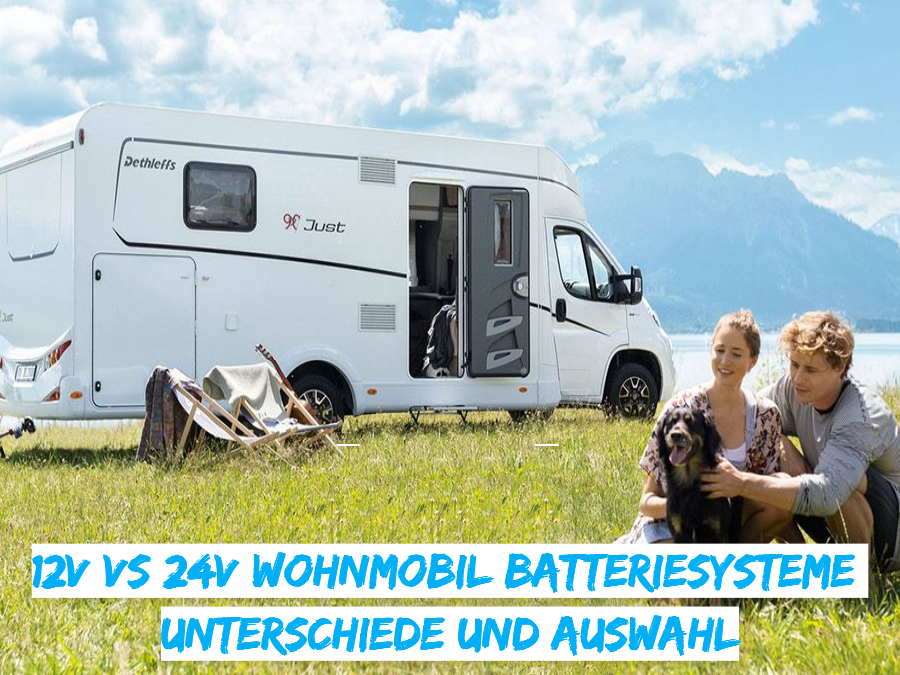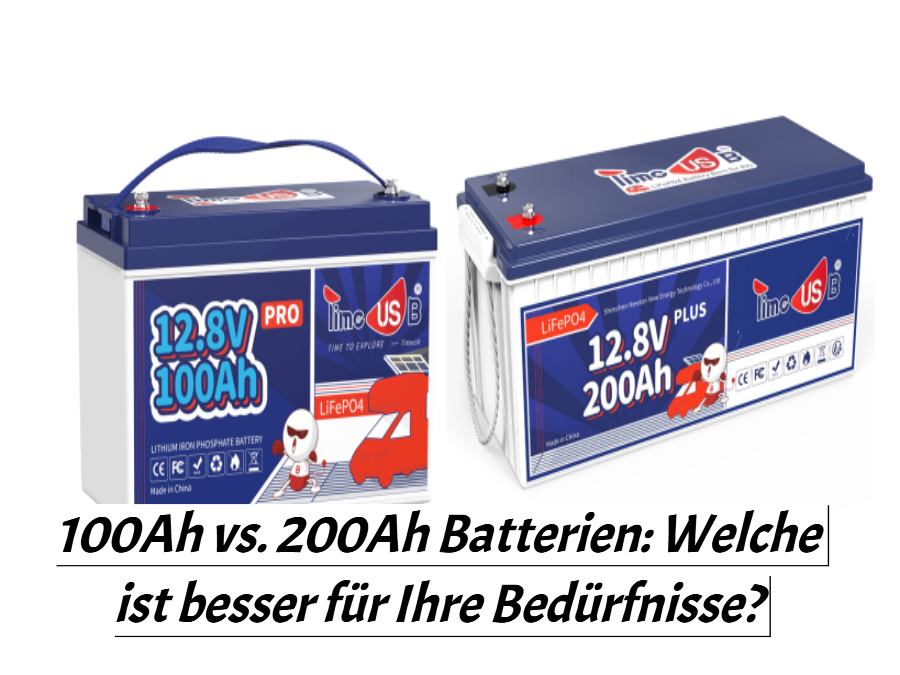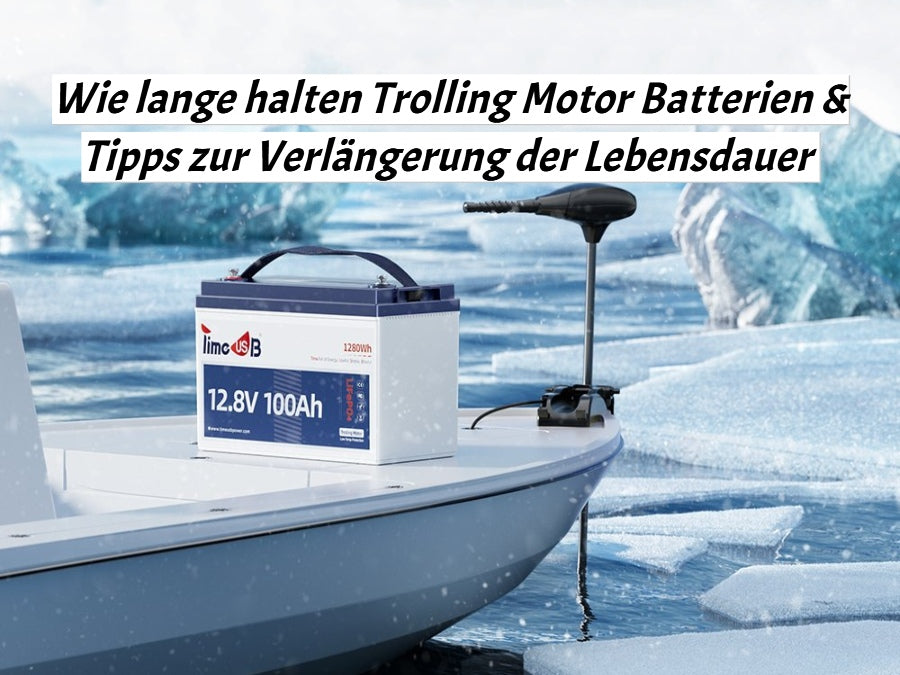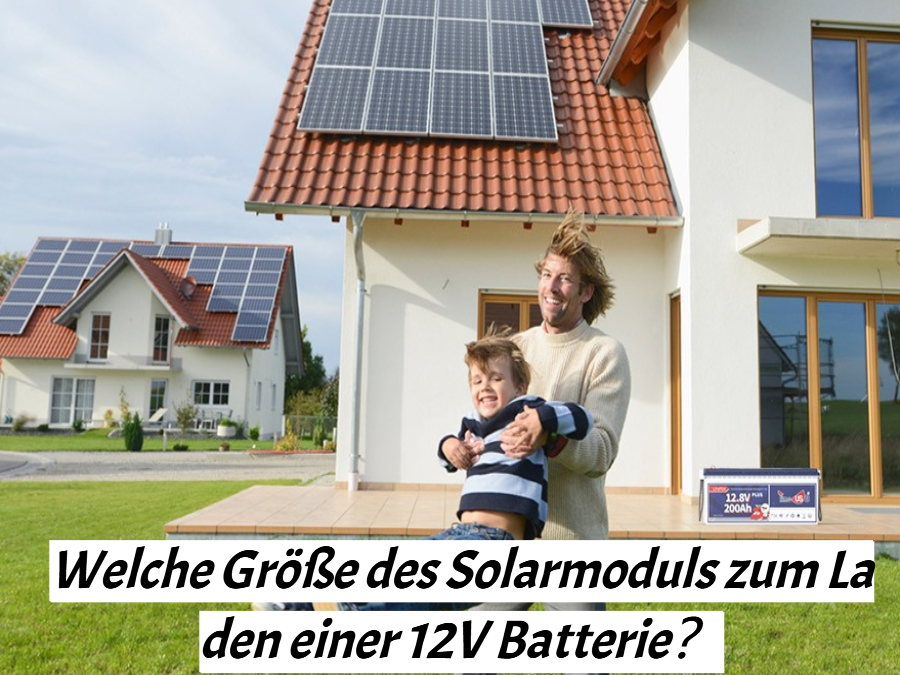12V VS 24V RV battery systems: differences and selection

When outfitting your RV for off-grid adventures or extended travel, one of the most important decisions you'll have to make is choosing the right battery system. The two most common options are 12V and 24V systems, each of which offers unique benefits depending on your power needs and build.
Knowing the differences and the advantages and disadvantages of the two systems will help you make the best decision for your individual needs.
Let's get started.
Table of contents
Part 1. Understanding the basics of 12V and 24V battery systems
12V and 24V battery systems are suitable for different applications depending on power requirements and efficiency requirements. 12V systems are the most common in motorhomes because they are compatible with most vehicle components and cover a power requirement of less than 3000W.
Conversely, 24V systems offer a higher voltage, which halves the current and reduces heat generation, resulting in higher overall efficiency.
The following explains the basics of 12 and 24 V battery systems and their common applications.
nominal voltage
The nominal voltage refers to the standard voltage assigned to a battery, which represents the average output voltage when fully charged. 12V battery, for example, is the most common among RV owners, as it is usually used to power motorhome lithium battery is used.
If your RV battery bank consists of 12V batteries and all DC devices (such as lights, fans and water pumps) run on 12V power, you need to make sure those batteries are receiving 12V.
Build a 12V solar power system for your campervan with Timeusb products!
However, you can develop a 24V battery pack instead of a 12V one for home and leisure use. This can be achieved either by using 24V batteries or by connecting two 12V batteries in series.
It is important to know the nominal voltage because, although it does not directly affect the storage capacity, it plays an indirect role in the performance of the battery.
Part 2. Differences between 12V and 24V motorhome battery systems
When outfitting your RV for off-grid adventures or extended travel, one of the most important decisions you'll have to make is choosing the right battery system. The two most common options are 12V and 24V battery systems, which offer different benefits depending on your power needs and setup.In this article, we'll look at the differences between 12V and 24V RV battery systems to help you decide which system is best for your lifestyle.
1. Power output and efficiency
12V systems:
- Standard choice: 12V battery systems are the standard for most RVs. They are compatible with a wide range of RV equipment, making them suitable for typical setups.
- Lower voltage, higher current: A 12V system operates at a lower voltage, which requires a higher amperage to deliver the same amount of power. This can cause the cables to be thicker and more power to be lost as heat.
- Efficiency: While 12V systems are reliable, they may be less efficient in certain applications due to the higher current required to supply power.
24V systems:
- Increased efficiency: With twice the voltage, 24V systems require half the current to deliver the same power as a 12V system. This means less energy is lost as heat and more efficient operation is possible, especially over longer distances.
- Smaller wiring: The lower current in a 24V system allows for smaller and lighter wiring, reducing the overall weight of the system and the complexity of installation.
2. System complexity and compatibility
12V systems:
- User-friendliness:12V systems are easier to install and compatible with most RV equipment and accessories. If you are upgrading or expanding an existing system, it may be easier to stick with 12V components.
- Availability: 12V components, from batteries to chargers and inverters are widely used and often cheaper due to their popularity.
24V systems:
- Advanced Setup: A 24V system may require more specialized components and careful planning. Not all RV equipment is compatible with 24V, so you may need converters or 24V specific equipment.
- Less common: Although they are becoming increasingly popular in certain applications, 24V systems are still less common in the RV world, meaning parts are harder to find and potentially more expensive.
3. Size and configuration of the battery bank
12V systems:
- Flexibility: 12V batteries are generally more flexible in terms of configuration. You can easily expand your battery bank by adding more 12V batteries in parallel, increasing the capacity without changing the voltage.
- Space requirement: 12V battery banks may take up more space if you need higher capacity, as adding more batteries increases the space required.
24V systems:
- Higher capacity with fewer batteries: 24V systems require fewer batteries to achieve the same capacity as a 12V system, saving space and reducing weight.
- Parallel and series configurations: While 12V systems can easily be expanded by adding batteries in parallel, 24V systems usually need to be connected in series to achieve the desired voltage. This can limit flexibility but simplifies the system overall.
4. Charging and maintenance
12V systems:
- Standard chargers: Most RVs are equipped with chargers, solar panels and generators designed for 12V systems, which simplifies maintenance.
- Easier maintenance: 12V systems generally require less specialized knowledge for routine maintenance and troubleshooting.
24V systems:
- Faster charging: Due to the higher voltage, 24V systems can be charged faster, provided you have a compatible charger and power source.
- Special chargers are required: For the Charging a 24V system Chargers and solar controllers specifically designed for higher voltages are required, which can increase initial cost and complexity.
Part 3. Motorhome applications: When to use a 12V and when to use a 24V system
Deciding between a 12V and 24V battery system for your RV depends on your specific power needs, the type of equipment you want to run, and how you assess the efficiency and complexity of the setup. Here's a guide to help you decide when to use which system.
3.1 When should a 12V system be used?
1) Standard caravan equipment:
- Typical devices: 12V systems are ideal for running standard RV appliances such as lights, fans, water pumps and other low to medium wattage devices. Most RV components are designed to run on 12V, making this system a practical choice.
- Easy compatibility: If your RV is equipped with 12V components, it is easier and more cost-effective to stick with a 12V system, especially if you want to expand or upgrade an existing system.
2) Lower power consumption:
- Power requirement under 3000W: For RVers with moderate power needs - such as short trips or minimal appliance use - a 12V system provides sufficient power without unnecessary complexity.
- Flexible expansion: 12V systems can be easily expanded by connecting additional batteries in parallel, giving you flexibility as your energy needs increase.
3) Cost and simplicity:
- Budget-friendly: 12V batteries and associated components are more widely available and generally cheaper than their 24V counterparts.
- Ease of installation and maintenance: A 12V system is easy to install and maintain, making it ideal for motorhome owners who prefer a simple setup without any specialist knowledge.

Timeusb 12V 100Ah H190 battery
3.2 When should a 24V system be used?
1) Powerful applications:
- Power-hungry devices: If your RV has high wattage appliances such as air conditioners, microwaves or other high-powered appliances, a 24V system will deliver the required power more efficiently.
- Extended off-grid use: For longer off-grid adventures where energy efficiency is critical, a 24V system reduces power consumption and heat loss, saving electricity over long periods of time.
2) Efficiency and weight saving:
- Long cable runs: If your RV requires long cable runs, a 24V system is beneficial as it reduces current, allows for thinner and lighter wiring and minimises energy loss.
- Smaller battery bank size: A 24V system can achieve the same performance with fewer batteries, reducing the overall weight of the system and the space required.
3) Advanced configurations:
- Optimized solar charging: If you rely heavily on solar power, a 24V system can improve charging efficiency and speed, making it easier to maintain a fully charged battery bank.
- Future-proof: For motorhome owners who are planning major upgrades or anticipate growing power needs, a 24V system offers a scalable solution that can handle increasing demands without requiring a complete overhaul.

Part 4. Considerations when choosing a 12V VS 24V RV system
4.1 Voltage drop and wiring considerations
Minimizing voltage drop and optimizing wiring efficiency are critical to ensuring your battery system effectively powers all components and devices. Voltage drop occurs when current flows through a conductor or cable, resulting in reduced power output.
Below you will learn how to reduce voltage drop and improve wiring efficiency in 12 and 24V battery systems.
1) Minimizing the voltage drop
To reduce the voltage drop in your battery system, consider the following strategies:
a. Increase system voltage:
- If you choose higher voltages, for example 24V instead of 12V, the current required for the same output power and therefore the voltage drop will decrease.
b. Use of voltage compensation devices:
- Tools such as voltage drop compensators, adjustable transformers and grid conditioners can help keep the voltage level stable throughout the grid.
c. Choose appropriate cable size and length:
- The size and length of the cable have a significant impact on voltage drop. Thicker wires with lower resistance and shorter wire runs will minimize voltage drop, although this can be challenging in larger RVs with extensive solar panel arrays that require long wire runs.
In a 24V system, doubling the voltage halves the current so you can use thinner wires. This is particularly beneficial in RVs with longer distances between the battery bank and the devices where the voltage drop would otherwise be more pronounced.
Proper management and distribution of loads can also reduce the impact of voltage fluctuations and ensure a stable power supply.
2) Improve wiring efficiency
A higher voltage in a 24V system can significantly improve wiring efficiency by reducing resistive losses and voltage drops over longer distances. The lower current in a 24V system allows the use of thinner wires, saving space, weight and cost.
In contrast, 12V systems often suffer from higher resistive losses, making them less efficient compared to 24V systems. When considering wiring costs, it is important to weigh the long-term benefits of each system before making a decision.
3) Power consumption and system efficiency
Power consumption and overall system efficiency are key factors in battery performance. Understanding these aspects in practical applications can help you decide between a 12V and a 24V system.
For the same output power, a 24V system draws half the current of a 12V system, resulting in lower losses and better efficiency. The exact current draw depends on the components and load requirements, but in general 24V systems are more efficient. The lower current allows for a smaller cable diameter, resulting in cost savings and easier installation.
4.2 Battery configuration: series vs. parallel
The way the batteries are configured - either in series or parallel - has a significant impact on the voltage and capacity of the system. Understanding these configurations is critical when deciding between 12V and 24V battery systems for your RV.
1) Serial circuit configuration
In a series connection, the batteries are connected in series, with the positive terminal of one battery connected to the negative terminal of the next. This increases the overall voltage of the system, while the capacity (measured in ampere hours or Ah) remains the same as a single battery.
For example, if you connect two 12V batteries with a capacity of 100Ah in series, you get a 24V system while the capacity remains at 100Ah. This configuration is important when upgrading from a 12V to a 24V system, as it doubles the voltage without affecting the capacity.
2) Parallel circuit configuration
In a parallel system, the batteries are connected so that all positive terminals are connected together and all negative terminals are connected. This keeps the voltage constant while increasing the capacity of the system by combining the amp-hour ratings of the batteries.
For example, if two 12V 100Ah batteries are connected in parallel, the total voltage remains at 12V, but the capacity doubles to 200Ah. This configuration is ideal for devices with high energy requirements, as it extends the runtime without changing the voltage.
Recommended reading: Wiring of battery in series VS. parallel
4.3 Effects on electrical components and devices
The compatibility of your electrical components and devices with the battery system you choose is crucial. Most RV components are designed to run on 12V systems and are therefore easily compatible. However, larger vehicles and some high-end RVs can run on 24V systems for efficiency. In these cases, an inverter may be required to step down the voltage for 12V devices.
For example, if your RV's appliances are designed for 12V, using a 24V system will require a DC-DC converter to reduce the voltage to 12V. The compatibility of your appliances with the voltage of your battery system is key to maintaining proper operation and efficiency.
4.4 Solar Power Systems and Charge Controller Compatibility
The integration of solar energy systems and MPPT (Maximum Power Point Tracking) charge controllers is critical for optimal performance of 12V and 24V battery systems. The solar panels must match the voltage of the system to function efficiently. For example, a 12V system requires solar panels and charge controllers rated for 12V, while a 24V system requires equivalent 24V components.
Charge controllers play a crucial role in controlling the power delivered by the solar panels to the battery bank. In a higher voltage system, such as 24V, the charge controller can handle more wattage for the same amperage. For example, a 70 amp charge controller can manage 1,000W in a 12V system, but 2,000W in a 24V system. This advantage allows for a larger number of solar panels and the use of smaller cables, improving the efficiency of the system.
When choosing a charge controller, it is important to consider factors such as the voltage of the battery bank, the input voltage of the solar panels, and the output current. The right selection will ensure efficient operation and prevent overcharging, protecting your RV's electrical system.
Conclusion
Both 12V and 24V RV battery systems have their advantages and disadvantages, and the best choice depends on your specific needs, vehicle size, and the types of equipment you want to run. For most standard RV setups, a 12V system offers a balanced, cost-effective solution. However, if you're looking for greater efficiency and lighter weight and are willing to invest in a more advanced system, a 24V system could be the right choice.
Understanding these differences will help you make an informed decision and ensure your RV battery system meets your travel habits and energy needs.
Timeusb offers 12V RV batteries to help you build a reliable leisure battery system. Visit Timeusb and subscribe to our newsletter for the latest information.




